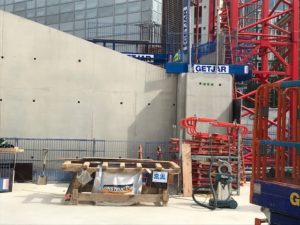One of the world’s most respected seats of learning, the London School of Economics (LSE), has a major new centre, the Paul Marshall Institute, under construction. This is due to open in 2021 and will house teaching facilities for LSE’s accounting, finance, management and research centres as well as restaurants, gyms etc for members of the university, plus the new Marshall Institute for Philanthropy and Social Entrepreneurship.
Architect renderings show how the 10-storey building, which includes two basement levels and a split-level roof terrace, will replace an ageing red brick structure that was demolished last year. Intended to be a distinctive and seminal piece of university architecture, it is designed as a landmark building which will enhance its Lincoln’s Inn Fields, Westminster location and help define an exciting and dynamic ‘University Quarter’.
Being in the very heart of the busy capital city, space is at a premium, hence the underground levels. Furthermore, the planning permission included conditions that the construction processes must be conducted in such a way as to minimise disruption to the immediate neighbours and wider locality.
The foundations and basement are of concrete construction, using both poured in-situ and pre-cast panel techniques. Poured concrete is used where irregular shapes are required, while pre-cast offers several advantages, including better quality control, reduction of weather delays and repeatable standardised production processes leading to productivity gains and lower costs.
Another very important advantage of pre-cast construction is that services can be cast into the concrete panels, which is more efficient than installing them in-situ. For its electrical services, the contractor is using the Spelsberg IBT range of electrical enclosures and fittings which has been designed specifically for use in concrete castings.
While it is possible to cast any electrical enclosure into concrete, those of a standard design are likely to encounter problems. Risks include failure of the seals, allowing concrete incursion into the enclosure; crushing of the enclosure under the weight of the concrete; difficulties in supporting the electrical equipment while the concrete is wet and stressing or failure of the enclosure as the building settles over time.
In contrast, Spelsberg’s IBT enclosures are designed specifically for use in pre-cast concrete. They are made to a robust and highly stable design and use a patented diaphragm sealing system rather than grommets that could be displaced by the concrete. They are mounted using a highly secure support spar, which is also patented, and can be used with both vertical and horizontal formwork. Importantly, they come in a virtually limitless variety of models and are very quick and easy to install.
The IBT range has been tried and tested over many construction projects and includes IBTronic enclosures, which are designed for the integration into concrete ceilings and walls to house high tech electrical equipment such as LEDs, low voltage or high voltage luminaires, loud speakers, and other components. Available in multiple sizes and shapes, the IBTtronic enclosures can be connected to one another, allowing bespoke solutions to be developed to meet the specific needs of individual applications.
Chris Smith of Spelsberg UK explains that while the IBT products are intended primarily for use pre-cast concrete construction, they can also be fitted in in-situ casting construction. “IBT is unique in the market in that it is the only range of electrical enclosures and associated equipment that has been designed specifically for use in concrete castings,” he says. “They are designed and built to address all the special requirements of such applications, including easy installation and adjusting to settlement of the building over time.”
The IBT range includes enclosures, switch and connector sockets, light boxes, installation boxes, universal luminaire housings and wall and ceiling ducting. All of these are designed for use with the multi-directional support spar – the secret to easy installation.
“Spelsberg is always ready to assist contractors in choosing the most appropriate enclosures and equipment for each particular building project,” says Chris. “We can also provide technical support to ensure that the installation process is followed correctly.”
He cites the LSE as an example of the extra support Spelsberg is able to provide: “For the LSE job, I went down to the site early in the project and taught the technicians how to cast the IBT units into the construction panels. On jobs like this where scheduling is ultra-important making sure everyone and everything can run smoothly is paramount, so I took the time to show people the full range of products and explain their advantages. We also went through practical issues such as where they would be stored on site and how to order extra parts quickly if required.”
When the new building is completed, it will be a landmark and help redefine the area as the new University Quarter. It will also enable the LSE to maintain and develop its global reputation for academic excellence. The decision to use precast concrete construction and Spelsberg IBT electrical equipment will have played a major, if unsung, role in the delivery of an important addition to the capital’s skyline.
 Instrumentation Monthly Test | Measurement | Control
Instrumentation Monthly Test | Measurement | Control




